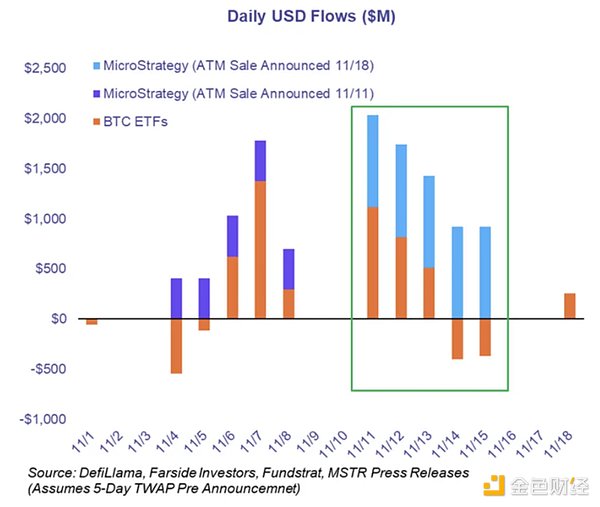
Author: Zack Guzman; Compiled by: Vernacular Blockchain
MicroStrategy founder Michael Thaler Saylor has become one of Bitcoin's most outspoken supporters, boldly declaring: "There is no second best option."
Since 2020, Saylor has purchased more than $30 billion in Bitcoin through his listed companies, and book profits have exceeded $14 billion, making MicroStrategy the enterprise with the largest number of Bitcoins. The strategy has won praise from Bitcoin maximalists but also raised skepticism from traditional investors.
However, as MicroStrategy continues to raise billions of dollars — with $42 billion in new funding planned over the next three years — it is betting four times on Bitcoin currency, external concerns are also increasing. Will this brew another huge bubble? How will MicroStrategy's bold move end if Bitcoin prices fall?
1. Echoes of Trading GhostsMicroStrategy’s Bitcoin strategy bears similarities to one of the most notorious trades in the crypto space, the “GBTC Premium Trade.” At the height of this wave of carry trades, investors gained exposure to Bitcoin through the Grayscale Bitcoin Trust (GBTC), which traded at a premium to the value of the underlying Bitcoin positions. They exchange loans for GBTC shares and earn premium income after the lock-up period ends.
This trade collapsed dramatically in 2021, when the GBTC premium turned into a discount. Companies that were overleveraged or associated with leveraged clients, such as Three Arrows Capital and BlockFi, collapsed one after another. A subsequent wave of bankruptcies, including that of Genesis, highlighted the risks of financial strategies built on fragile market imbalances.
Now, critics warn that MicroStrategy is walking a similar tightrope. But instead of leveraging the GBTC premium, MicroStrategy has opened up a new path for leveraged Bitcoin trading through its own stocks and bonds—effectively turning the company into a leveraged Bitcoin agent.
MicroStrategy's Bitcoin purchasing behavior in some periods
2. The magic of convertible bondsThe core of MicroStrategy's strategy is to issue convertible bonds Raising money with debt and stocks, here's how it works:
Borrow at low interest rates (0%) MicroStrategy offers bonds with extremely low or even zero interest rates to bondholders .
Offering the potential for stock appreciation in return, bondholders can convert the bonds into MicroStrategy stock if the stock price rises. The potential gains have attracted a number of institutional investors, including Allianz, Germany's largest insurance company.
The funds raised by buying more Bitcoins are then used to buy more Bitcoins, driving the stock price even higher.
This feedback loop has allowed MicroStrategy stock to perform spectacularly, rising nearly 500% in 2024 alone. The strategy was so successful that bond investors, lured by the potential appreciation in stock prices, were willing to lend the company billions of dollars at 0% interest.
This is an attractive argument: Why settle for low interest rates on bonds when MicroStrategy can double or even quintuple your investment? Chance? As Saylor said in a recent investor call, bondholders are fleeing a world of “negative real returns” in pursuit of the potential gains that come with Bitcoin.
Currently, MicroStrategy's strategy is working extremely well, with rising Bitcoin prices creating a virtuous cycle. But what happens if Bitcoin’s trend reverses?
MicroStrategy owns nearly 387,000 Bitcoins and is worth about $37 billion, but its stock market valuation is over $100 billion. This sky-high valuation relies heavily on the assumption that Bitcoin’s price will continue to rise. If Bitcoin falls, the company's stock price - essentially a leveraged bet on Bitcoin - could plunge significantly.
It should also be noted that, like MSTU and MSTDouble-leveraged ETFs like
All of this has driven huge Bitcoin purchases. MicroStrategy’s buying volume actually far exceeded the combined inflows into all Bitcoin ETFs earlier this month, according to research from Fundstrat. If the market begins to doubt MicroStrategy's ability to meet its $42 billion funding target, the price of Bitcoin could fall, further jeopardizing MicroStrategy's ability to raise capital. And once this situation changes, the situation can quickly deteriorate. Similar situations occurred with FTX’s attempts to raise capital when it needed it most, and with Terra during its $40 billion collapse.
Although Saylor has repeatedly emphasized that the company will never sell its Bitcoin, this stance may be difficult to maintain if debt pressure increases and Bitcoin prices fall.
3. Historical lessonsThe cautionary tale of GBTC premium trading is still fresh in our minds. When market conditions changed, this bubble burst, exposing the fragility of the leveraged strategy. While MicroStrategy’s approach avoids some of the pitfalls of GBTC trading — it doesn’t rely on an inefficient fund structure, for example — it also faces a core risk: Leverage could magnify losses if the price of Bitcoin falls.
Saylor's strong belief in Bitcoin may inspire confidence, but history shows that markets cannot rise indefinitely. Just as overconfidence in a "self-sustaining system" led to $40 billion in losses when Terra crashed in 2023, MicroStrategy's stock price could face a similar moment of reckoning if Bitcoin prices fall.
However, for those Bitcoin supporters who believe the United States will follow suit and include Bitcoin in its strategic reserves, MicroStrategy's bet has the potential to be The greatest investments in history are either known as "moves of genius" or as "miserable failures."










